You're using an outdated browser. Please upgrade to a modern browser for the best experience.
Please note this is a comparison between Version 2 by Muhammad Dangana and Version 3 by Bruce Ren.
Narrow-Band Internet of Things (NB-IoT) shares among the challenges faced by Internet of Things (IoT) and its applications in industrial settings are set to bring in the fourth industrial revolution. The industrial environment consisting of high profile manufacturing plants and a variety of equipment is inherently characterized by high reflectiveness, causing significant multi-path components that affect the propagation of wireless communications—a challenge among others that needs to be resolved. The suitability of NB-IoT for industrial applications is therewith explained.
- Narrow-Band IoT
- Internet of Things
- Industrial IoT
- wireless communication
- latency
- self-organizing network (SON)
- edge computing
- long term evolution (LTE)
Note: The following contents are extract from your paper. The entry will be online only after author check and submit it.
1. Introduction
The development of ad hoc Wireless Sensor Networks (WSN) contributes to the paradigm of the Internet of Things (IoT). Many wireless technologies have emerged with this paradigm; among these are the Low Power Wide Area Network (LPWAN) such as Narrow-Band IoT (NB-IoT), Long Term Evolution for Machines (LTE-M), Long Range Wide Area Network (LoRaWAN), SigFox, etc. Since IoT involves the connectivity of massive objects to the internet for information or data gathering, monitoring, and control, a highly reliable platform is required. As such, the focus has been on the requirements that will establish this reliable connectivity. Wireless technologies are therefore geared towards meeting these requirements among which include: low power consumption, to enable longer duration of connectivity and energy savings; coverage range, for extended object reachability; reliability, for error-free data transmission and network availability; security, for data confidentiality, integrity, and availability; latency, for real-time data delivery.
The standardization of NB-IoT technology by the Third Generation Partnership Project (3GPP) in 2016 [1] has empowered NB-IoT with features that have enabled it to be suitable for wireless data communication. The expanded Discontinuous Reception (eDRx) and Power Saving Mode (PSM) techniques allow NB-IoT to implement its low power consumption scheme. For a more extended coverage range, the technology employs the re-transmission and low-frequency modulation mechanisms. For a low latency sensitivity level, 3GPP has prescribed a tolerable latency level of 10s. The superimposition of NB-IoT on Long Term Evolution (LTE) provides the support and reliability needed for its network availability.
These 3GPP standardization features have increased the presence of NB-IoT modules in the forecast of the IoT device market share by 2030 [2]. Many wireless vendors have entered into the business of IoT manufacturing. Since NB-IoT is integrated into the LTE infrastructure, this has resulted in its application in numerous industrial sectors, such as agriculture, transportation, automobile factories, logistics and manufacturing, while increasing the data transmission over LTE infrastructure. However, the structural settings of these industries differ and are comparatively unique. The uniqueness of these industries is characterized by heavy machinery and in some cases with metals that are highly reflective to wireless signals. These forms of settings present a harsh condition for wireless communications [3].
The deployment of NB-IoT in indoor industrial environments is faced with these harsh channel conditions, and as such, a more appropriate wireless propagation model is needed to describe the wireless system of NB-IoT communication in an indoor industrial environment. Attempts have been made to characterize the wireless propagation of narrow-band in industrial settings [3][4][3,4]. Reference [3] performed physical measurements of wood and metal processing factories for large-scale and temporal fading at frequencies of 900, 2400, and 5200 MHz. The authors identified and classified the features of the industrial environments that affect the large-scale and temporal fading. Of interest is the presentation made by [4] on its comparative analysis of indoor industrial environment propagation models with a generic representation of path-loss for 900 MHz.
This paper presents a survey on NB-IoT, and as a future direction, some research areas are discussed in a bid to bring forth an appropriate representation of the NB-IoT network. This is to aid in designing suitable wireless communication systems that can be used in developing a reliable scheme for the measurement of an acceptable threshold for NB-IoT wireless performance in industries, measuring the tolerable latency sensitivity level as described in 3GPP, and analyzing the effect of the propagation model on power consumption rates in NB-IoT.

Figure 1. A structural description of the paper layout.
Table 1. Highlights of some research work.
| Category | Discussion | Ref | Year |
|---|---|---|---|
| NB-IoT | Survey the features of NB-IoT and its application in industries | [5] | 2019 |
. IoT connectivity is mostly consumer-grade and is used for building automation, human wearables, and messaging, etc., while in IIoT, the connectivity is secured and targeted at the automation of industrial processes such as in defense, aerospace industries, etc. [50]. Table 2 further shows the comparisons between IoT and IIoT based on their respective characteristics [21].
Table 2. Comparisons of IoT and IIoT characteristics.
| Types | Data Volume | Connectivity | Exchange of Information | Market Segment | Criticality | Impact | |
|---|---|---|---|---|---|---|---|
| IoT | Big data | Consumer grade, e.g., smart homes, entertainment, etc. Business to consumers, business to business to consumers | Service providers, consumers, limited enterprises, and small businesses | Not stringent (Excluding medical applications) | Revolution | ||
| Features of some LPWAN are compared for industrial applications | |||||||
| IIoT | [6 | Specific and limited data | Secured, e.g., health care, energy, etc. | Business to business only | Enterprises and Industries | Critical for timing, reliability, privacy, and security | Evolution |
2.2.1. IoT the Enabling Technology for IIoT
Cloud computing, Machine-to-Machine (M2M), Artificial Intelligent (AI), and Blockchain are among the large group of technologies that enables effective and reliable IIoT [52], with IoT forming the backbone. Figure 6 shows the structure of a typical IoT technology. The things here are regular objects, such as a VR headset, watch, electric cooker, parking lot or garage, security cameras, shopping cart, etc., that are made smart because of the sensor nodes embedded in them. This sensing ability enables these things to interact through a common infrastructure, the Internet, with a management center for decision making. The interaction is possible through the various wireless communication technologies available. For the protection of data, a firewall is designed to secure the information exchange between the objects and the center. Communication device manufacturers have provided solutions to protect this data. The network layer provides the platform on which different communication technologies can function. These include long-range licensed and unlicensed wireless bands. The licensed wireless technology, such as 2G/3G and LTE involves, the use of existing telecommunication infrastructures, while the unlicensed wireless (LoRa, ZigBee, etc.) is an ad hoc setup with Internet capability (through an Internet modem or a gateway). The smart objects, set up in this fashion, have various applications such as in homes, city environment, traffic, etc. Their management is also done through any internet-empowered device such as smartphones, laptops, tablets, etc. Figure 7 represents the application of IoT in the industrial environment, the IIoT. In industrial applications, the sensor nodes are embedded in the industrial equipment for monitoring, operations, and management. The communication technologies remain the same; however, the processes that are managed are of critical nature. Applications include oil and gas industries, chemical, automobile, food processing industries, etc. While IoT could be less stringent in terms of criticality, IIoT is critical with timing, reliability, privacy, and security of data being gathered in operation or monitoring.

Figure 6. A typical structure of consumer-based IoT showing basic layers.

Figure 7. A typical structure of Industrial IoT (IIoT) showing basic layers.
2.2.2. The IoT/IIoT Communication Technologies
IoT and IIoT are thought to have three or five architectural functionality layers [53][54][53,54]. Meanwhile, in [55], for a Man Like Nervous (MLN) system, other layers are involved. Three-layered IoT/IIoT architecture include perception, network, and application layers. While in five-layered architecture, in addition to the three layers are processing and business layers. However, in any type of architecture proposed or adopted, the network or transport [53] layer is responsible for the communication of devices among themselves and with the network infrastructure (e.g., gateway, server, etc.). IIoT allows the industries to meet their operational targets, among other things. However, most of the peculiar needs of the industries are centered on the capabilities of communication technologies as supported by the network layer. These designs need to include latency—time required for data propagation and processing, topology–device connection style, throughput—the volume of data that the network can support, scalability—number of supported devices in the network, the security of data and energy—IoT device operational time without power supply [56]. Table 3 lists the common types of communication technologies used by IoT/IIoT and the network-supported features.
Table 3. Common IoT/IIoT wireless communication features.
| Type | Latency | Bandwidth | Data Rate | Coverage Range | Energy | Security | Scalability | Ref. | |||||||||
|---|---|---|---|---|---|---|---|---|---|---|---|---|---|---|---|---|---|
| NB-IoT | 1–10 s | 200 KHz | 200 kbps | 1 km/10 km (Urban/Rural) | 10 years battery life | Yes | 52,000 | [5][6][9][57][58][59] | [5,6,9,57,58,59] | ||||||||
| ] | |||||||||||||||||
| LoRaWAN | 2019 | ||||||||||||||||
| 600 ms | 250 KHz and 125 KHz | 50 kbps | 5 km/20 km (Urban/Rural) | >10 years battery life | Yes | Approx. 104 nodes/BS | [ | 5][6]] | [5 | [58 | ,6 | ][59][60 | ,58,59,60] | Overview of NB-IoT | [1][7] | [1,7] | 2017 |
| SigFox | 1–20 s | 100 Hz | 100 bps | 10 km/40 km (Urban/Rural) | >10 years battery life | Yes | Approx. 106 nodes/BS | [5][6][58][59][60] | [5,6,58,59,60] | Evaluates the coverage performance of NB-IoT | [8] | 2016 | |||||
| Bluetooth | 200–500 ms | 1 MHz | 3 Mbps | 10 m | 72 microwatts | Yes | 8 | [58][59][61][62][63][64] | [58,59,61,62,63, | Presents NB-IoT architecture through the perspective of 3GPP | [9] | 2017 | |||||
| Explanations on the automation of Industries with Narrow-Band Internet of Things Technology | [10] | 2020 | |||||||||||||||
| Did a comparative analysis between two LPWAN viz; NB-IoT and LoRa on Power Wireless Private Network (PWPN) | [11] | 2018 | |||||||||||||||
| Studied the performance of NB-IoT and its latency-energy levels. | [12] | 2020 | |||||||||||||||
| Evaluates the Power Saving Mode (PSM) and Expanded Discontinues Reception (eDRx) schemes of NB-IoT and a developed energy model | [13] | 2018 | |||||||||||||||
| Surveyed the energy efficiency of NB-IoT, its applications and challenges | [14] | 2019 | |||||||||||||||
| Highlights the applications and implementations of NB-IoT | [15] | 2017 | |||||||||||||||
| 64 | ] | ||||||||||||||||
| Wifi | 20–250 ms | 22 MHz | 11 Mbps–10 Gbps | 100 m | 0.2 watt | Yes | 2007 | [58][59][61][62][63][64] | [58,59,61,62,63,64] | ||||||||
| ZigBee | 60–150 ms | 0.3/0.6 MHz, 2 MHz | 250 kbps | 10–100 m | 90 microwatts | Yes | 65,000 | [ | NB-IoT, SigFox, Lora and GPRS coverage range were compared in an area of 7800 km | 2 |
| [16] | 2017 | ||
| A study of the technical representation of NB-IoT from physical to its media access control layers | [17] | 2019 | |
| Proposed an uplink adaptation scheme for uplink scheduling in NB-IoT | [18] | 2017 | |
| Studied the performance of NB-IoT and eMTC in the implementation of smart cities | [19] | 2018 | |
| IIoT | Analytically proposes IIoT architecture | [20] | 2018 |
| Presents the opportunities in IIoT, its features, and challenges | [21] | 2018 | |
| Review on IIoT | [22][23] | [22,23] | 2018 |
| Optimized QoS through wireless transmission in IIoT | [24] | 2020 | |
| Demonstration of IIoT by the inclusion of gateway | [25] | 2019 | |
| Uses machine learning for IIoT | [26] | 2020 | |
| IoT | Identify the evolution of radio frequency identification in IoT technology | [27] | 2008 |
| Survey the impact of IoT on technology, social, and businesses | [28] | 2018 | |
| Survey the architecture and features of IoT | [29][30][31][32][33][34] | [29,30,31,32,33,34] | 2018, 2017, 2016, 2020, 2019, 2019 |
| WSN | WSN and its types surveyed | [35] | 2018 |
| Survey WSN in Agriculture | [36] | 2016 | |
| Discuss the application of WSN in the monitoring of the environment | [37] | 2012 | |
| Presents the requirements and challenges in the application of WSN in oil and gas industries | [38] | 2018 | |
| Proposes the use of WSN and IoT in oil and gas industries | [39] | 2017 | |
| Described application of WSN in industrial automation | [40] | 2008 | |
| The standardization process in industrial WSN for industrial automation | [41] | 2010 |
Research Methodology
Among the contributions of this paper are, firstly, to review the state-of-the-art research in the field of NB-IoT technology and its applications in industrial environments. To review other IoT technologies (WSN, IoT, and IIoT) upon which NB-IoT is established. This is aimed at understanding the relationships and impact of these technologies with NB-IoT, especially in terms of technical features, applications, and challenges in industrial environments. Lastly, to highlight the challenges and future directions of wireless communication of NB-IoT in industries. This paper reviewed research carried out in recent years in the field of Industrial Internet of Things (IIoT) application with some notes on earlier contributions. The process of this review involved a thorough checking of the significant contributions made by journals, articles, conference papers, and report papers. The scholarly databases were systematically queried to extract important information from the literature identified. A total of 368 papers were pulled out of the databases, and 116 papers were selected and comprehensively read, analyzed, and categorized based on their areas of review. Figure 2 depicts the paper extraction procedures. The first process screened out or excluded papers that were in duplicates, non-English written, and had text wrongfully categorized concerning the area of review interest. The review process began with the inclusion of papers on the basis of titles, abstracts, keywords, and conclusions. A total number of 116 papers were finally selected by article type (survey or review, theoretical, practical, etc.). Data were also extracted at this stage to include both theoretical and experimental contents. The third process of the review focused on the challenges that are related to the communication characteristics as supported by the network layers.
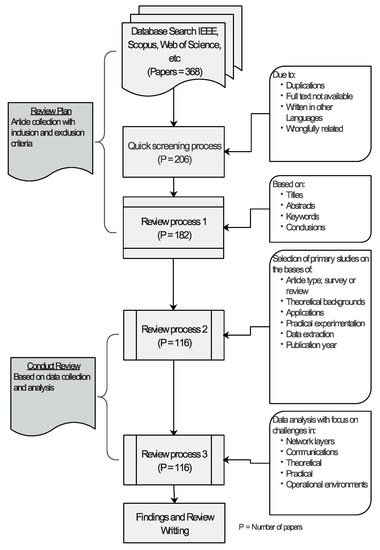
Figure 2. Data extraction procedure.
2. Technical Background of NB-IoT
The evolution of the Internet of Things (IoT) has occurred in recent years, with a forecast on IoT device connectivity running into billions in 2021 [2]. The standardization and careful research into technology has also led to meaningful progress. This section, therefore, briefly describes some of the features of WSN, IoT, Industrial IoT (IIoT), and NB-IoT, as well as their technical challenges.
2.1. The Wireless Sensor Networks (WSN) Technology
WSN is a set of sensing nodes that are arranged in a manner that allows them to function together to monitor or read some physical quantity (such as temperature, humidity, pressure, etc.) and communicate to a central point or device wirelessly. The full structure of WSN comprises the sensors (nodes), the communication technique, and the nature of their inter-connectivity. This implies that WSN has the capabilities of sensing, processing, storing, and communicating with its data destination through the wireless medium.
2.1.1. Structure of a Typical Sensor Node
To understand the WSN technology, a study of a typical sensor node is important. Figure 3 shows the four major units of a node: power, sensing, processing, and transceiver units. The power unit provides the energy required by other units in the node. This power source in most cases is provided by a battery. The sensing unit monitors the physical quantities that are presented in analog form or signals. With the aid of an Analog-to-Digital converter (ADC), the analog signal is converted to a digital signal. Both the sensor and ADC form the sensing unit. The digital signal is then processed by a micro-controller or processor. The processed data are stored temporarily in the storage section of the processing unit. The transceiver unit enables the node to connect with other nodes or the gateway in the network [42].

Figure 3. A detailed representation of the four units of an IoT node.
2.1.2. WSN Network Architecture
The network architecture of WSN is considered to be of two types: structured and unstructured [43]. A structured WSN network design provides for a well-mannered approach to its planning and distribution of the nodes. With this type of deployment, the network maintenance rate is minimal, which leads to a low management expenditure as well. While in an unstructured network, the nodes’ distribution and placements are scattered without proper planning. This type of design features dense and random deployment of nodes. This will lead to uncovered areas of deployment in the field, which may in-turn need monitoring. Since the nodes are not carefully placed, node failure detection and connectivity management become difficult to handle. Sensor nodes are of different types, which are designed or described based on the type of physical quantity they monitor. As shown in Figure 4, sensors such as humidity, temperature, flow, vibration, power sensors, etc., are connected wirelessly to a base station that is capable of aggregating data gathered from the sensors to the network server. The user computer connects with the server to access the data and further process the data, which will be presented in a format that is more understandable by the decision making team. The wireless media used by these nodes enables a multi-hop communication. These communication links could be provided by radio or infrared technologies. Where a radio link is used, WSN often uses the unlicensed frequency band known as the Industrial, Scientific, and Medical (ISM) band [42]. These frequency bands are specified by the International Table of Frequency Allocations, and they also provide huge spectrum allocation and are unregulated but highly prone to interference.
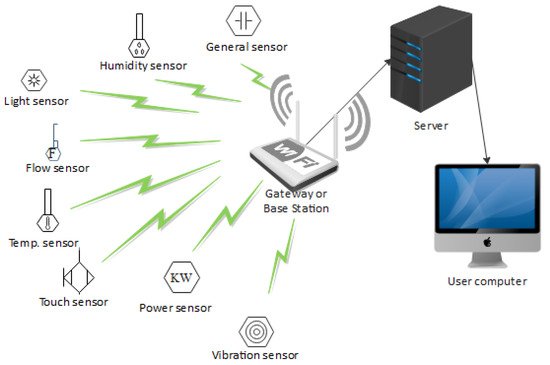
Figure 4. A WSN network architecture showing data sources, aggregation, storage, and control points.
2.1.3. WSN Topology and Types
The description of WSN topology is associated with the expected capabilities of sensor nodes, which enable the deployment of several numbers of nodes in a sensor field [44]. While four major types of topologies can be adapted for field deployment, such as, star, tree, point-to-point, and mesh topologies [36], well-planned handling of these arrangements are necessary for maintenance purpose [42]. Without a proper topology arrangement, maintenance-related issues become difficult to handle. These issues usually arise in deployment phases: pre-deployment and deployment phase, post-deployment phase, and redeployment of more nodes phase [42]. In some cases, the types of WSN are classified based on the field of application, such as health, industry, military, agriculture, etc. [45]. However, WSN types can be identified as terrestrial, underground, underwater, mobile, and multimedia wireless sensor networks [46].
2.1.4. Challenges Facing WSN
Although WSN technology has had performance improvements over the years [47], with many research questions getting resolved, other challenges are still present. Some of these challenges arise from node structure, while others are posed by the environment in which they operate in. Reference [48] highlighted some of these design challenges encountered by WSN. These include the operational environments, where WSN are deployed in areas that affect its operation, such as the industries, underwater, underground, etc.; the power consumed by nodes to process its data, transmit it, or receive any data; the scalability of these nodes, since they are deployed in large numbers for a specific application; provision of good quality of service; fault tolerance in the network; limitation in computational and storage capabilities; security of data in terms of confidentiality, integrity, and availability.
2.2. The Internet of Things (IoT) and Industrial Internet of Things (IIoT) Technologies
The advancement in IoT has lessened direct human intervention with objects that are capable of sharing information among themselves and the environment. Designed with sensing and actuating capabilities, these objects have become smart, considering their ability to communicate and autonomously react to real-time or physical events through a unifying infrastructure [49][50][49,50]. The interactions of sensors with Radio Frequency Identification (RFID) and the introduction of Internet Protocol (IP), which enables the identification of nodes and their location as well as easy routing on the Internet [51], have transformed WSNs into IoT. Figure 5 shows the forecasted increase in the IoT devices by 2030, however, this is an estimate as signifies by the asterisk. As the number of IoT devices grows tremendously to about 50 billion worldwide [2], the IPv4 identification process will be exhausted, and IPv6 becomes useful for supporting this increase in the IoT paradigm.
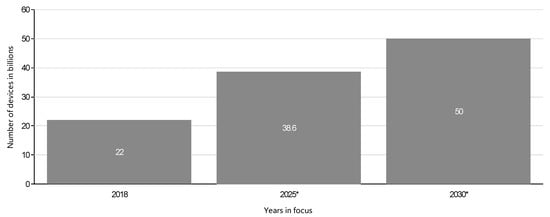
Industrial IoT is simply the introduction or application of IoT in industries, especially in manufacturing [20][50][20,50]
The network or transport layer handles the coverage range of IoT/IIoT. Each type of communication technology has an approximate range it can cover. Therefore, depending on the requirements needed for an application, appropriate technology can be employed. However, for IIoT where timing is critical, latency is an important feature that needs to be put into consideration to achieve reasonable reliability of deployment. To this end, a true picture or understanding of the industrial wireless communication for the application of IoT is necessary.
2.2.3. IIoT Challenges
Some of the challenges faced by Industrial IoT are the requirements needed for their deployment in various settings. Although different fields of application have their requirements [21], most of these requirements are expected or provided by the network layer of the IoT architecture. For example, in [66], the scalability, throughput, latency, energy consumption, topology, and security of data were explained. More so, the interoperability of devices to support the heterogeneous nature of IoT is presented as a future requirement for IoT in [67]. Standardization, architecture, and the need for an increase in storage are some other challenges that IIoT faces [68]. This research paper presents the challenges that are related to the network layer.
Scalability: The capacity provided by the global information infrastructure to connect a large number of common objects describes the scalability. This challenge can present itself on different levels [69]. The addressing and identification of devices pose a challenge; however, this issue is mitigated by the use of IPv6 and 6LoWPAN protocols [70]. Due to the large size of these connected objects, a high volume of data communication (big data) and networking capabilities are issues to be tackled. The application layer also contributes to the challenge posed by scalability as a result of the numerous services and service execution options that are generated by heterogeneous connected IoT devices. Therefore, one of the challenges in scalability is the ease of adding new devices to the network without major interruption.
Latency: Since the industrial application of IoT is time-critical and usually deployed in environments that are noisy and hard on the wireless communications, the Quality of Service (QoS) provided by IIoT is often characterized by the real-time achievement of the deadline set by an end-to-end communication task, from sensing to control execution in the system [71]. In industries, various communication traffic is generated, and depending on the type, the latency and reliability provided by IIoT can either be least critical or most critical. These types of traffic are explained in [72]. Table 4 presents a summary of the latency and reliability levels needed for the communication traffic.
Table 4. Latency and reliability summary for industrial communication traffic.
Industrial traffic (data) that requires fractions of seconds in latency in IIoT communications includes the emergency, critical control, and remote control traffics. This traffic is used for safety purposes, such as the leakage of radiation or poisonous gases in industries [72], continual flow of industrial processes such as automation processes, which require 1 ms latency rate [73], and control of unmanned vehicles, which require 50 ms latency and 1–10−8
Energy consumption: The primary energy supply to IoT is batteries. The replacement of these batteries becomes difficult when they are fully drained. However, energy harvesting techniques are becoming promising in resolving this challenge. Ideas and research are already moving toward techniques where solar panels or piezoelectric material will be used to relieve IoT devices from the shackles of battery operations [69]. Meanwhile, efforts have been made to optimize the network protocols in the wireless communication systems. These protocols are optimized to help in reducing the amount of energy consumed by these devices. Examples are the implementation of idle time of the devices when transmission or reception of data is not taking place.
Security: Data generated by IIoT are important assets to the industry management, and while lack of proper security of these data is yet to be provided, this provides the reason why some industries are yet to fully deploy IoT. Although some traditional security mechanisms are in use, these are not sufficient enough to protect the complexity of the IIoT systems. These mechanisms include secure protocols in [75], privacy assurance in [76], and lightweight cryptography, as described in [77].
2.3. The Standardization and Technology of NB-IoT
NB-IoT is one of the licensed frequency band communication technologies that were standardized by the 3GPP [1]. This technology is fused into LTE infrastructure as it is also an LPWAN-based technology. Among its category of LPWAN but utilizing the unlicensed frequency bands are LoRaWAN, Ingenu, SigFox, etc. NB-IoT is characterized by low-cost deployment and long-range coverage [17]. The use of the already existing cellular infrastructure by NB-IoT makes it a good candidate for the deployment of IoT as it provides a standardized common platform for the connectivity of objects. Among the advantages of NB-IoT include support for an effective cellular communication network, wide radius coverage with bidirectional triggering between data and signaling planes, low power consumption rate, and capacity to support the massive connections of devices [15][78][15,78].
2.3.1. Standardization of NB-IoT
NB-IoT has passed through a series of standardization by 3GPP. Figure 8 describes a brief history of NB-IoT standardization from inception to its current freezing state. The diagram is a unique representation of the standardization history as it captures the various stages at a single glance. The standardization started in 2005 when 3GPP Release 8 (R8) was specified to cater for massive device connections, billing of usage, addressing, machine type communication mode, and security issues. All the standardization versions have a start date and end date with overlapping of some specific technological fields of concern. Examples are the versions R12 and R13 with various standardization numbers and specific areas of concern. In 2015, Version R13 was released with features that further reduced the energy consumption rate of NB-IoT through the implementation of eDRX and PSM mechanisms [15].
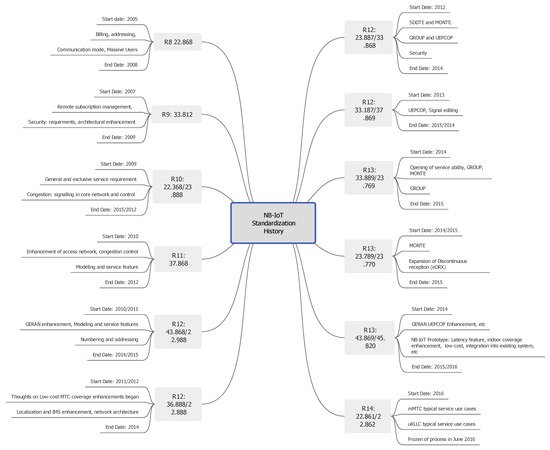
Figure 8. A unique representation of the NB-IoT standardization process.
Figure 9 shows the major technology companies involved in the standardization process [79]. These companies include Vodafone and Huawei; they paired together to work on NB-IoT M2M communication features and made their submission in May 2014; Qualcomm presented NB-IoT Orthogonal Frequency-Division Multiplexing (OFDM) in August 2014. The works of the above formed the NB Cloud IoT (NB CIoT); a year later, Ericsson presented the LTE features of NB. These works were fused by rapporteurs in September 2015 to form the NB-IoT 3GPP Version R13 work item with a standardization number of 45.820. In this version, the following technological features were addressed: reduced latency, improved indoor coverage, ability to be compatible with existing infrastructure (LTE), support for a low data and low cost terminal.
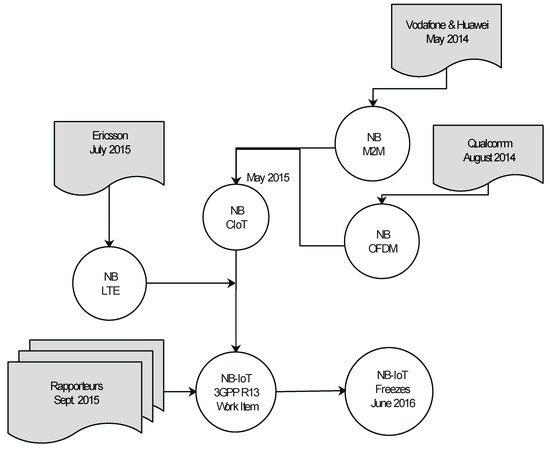
Figure 9. Participating companies in NB-IoT standardization.
2.3.2. NB-IoT and Its Features
Some of the main features of NB-IoT are enhanced coverage range, low energy consumption rate meaning long battery life, capacity to connect a massive number of devices per cell, increased reliability, low cost of the terminal and various deployment modes. These features are briefly explained below.
Coverage and Latency: NB-IoT gives better coverage as compared to the legacy LTE with 20dB performance. This allows it to deliver to areas that are difficult to reach, such as basements, making it suitable for use in underground car parks. NB-IoT can achieve this coverage either by in-band, stand-alone, or guard band deployment modes. The 20 dB coverage enhancement is supported by retransmission and low-frequency modulation mechanisms. With the two retransmission tones (3.7 and 15 kHz) available for use, NB-IoT can retransmit using up to 128 bits for uplink and 2048 bits for downlink. The latency budget of NB-IoT is 10 s, but a lower latency of 6 s can be achieved for maximal coupling losses as simulated and specified in TR45.820 [1][17][1,17].
The transmission tone feature, which enhances the coverage capability of NB-IoT is presented uniquely in a block diagram in Figure 10. The diagram presents the operational bandwidths of NB-IoT; 200 kHz for stand-alone deployment and 180 kHz for both in-bound and guard-band deployments. For the uplink transmission, NB-IoT uses a Single Carrier Frequency-Division Multiplexing Access (SC-FDMA) modulation scheme. With this modulation scheme, it operates at 3.75 or 15 kHz sub-carrier intervals. These single-tone carriers are at 32 and 8 ms, respectively. The transmission rates used are from 160 to 200 kb/s to achieve a large coverage range that is powered by its high spectral density. The downlink transmission, however, uses an OFDMA modulation scheme with only a 15 kHz sub-carrier interval. It also utilizes multi-tone carriers of 3, 6, and 12 ms that support 160 to 250 kb/s transmission rates. The coverage enhancement of NB-IoT to achieve a 20dB was evaluated in [80], and it was shown that this is true as compared to the legacy LTE.
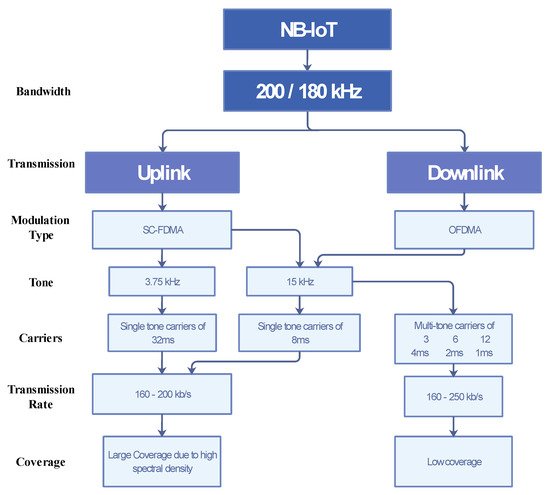
Figure 10. Block diagram of transmission tone mechanism.
Low energy consumption: The standardization process of the NB-IoT introduced the PSM and eDRX mechanisms for low energy consumption. In the PSM, the device remains registered to the network of transmission but usually enters a deep sleep mode and completely switches off most of its circuitry; at this stage, the device is not reachable from the network. Meanwhile, it could wake up at any time to transmit data when necessary. The eDRX is a temporary idle state that does not listen to the radio channel but periodically becomes active to receive paging messages from the network for possible incoming data before switching to PSM. This periodic activeness is guided by a specified timer, and the paging system is the process of monitoring the control channel for downlink or uplink data indication. Without any activity on the control channel and the expiration of the specified timer, the device switches from the idle state to the PSM state. These two basic features allow for the energy saving of NB-IoT, which surpasses the legacy LTE. Figure 11 shows the idle and paging states [13]. Timer T3324 is the time required to enter into deep sleep mode.

Figure 11. The PSM and eDRX modes.
NB-IoT Deployment modes: NB-IoT is stipulated by RP-151621 to be deployed in FDD transmission [15] and has three types of deployment modes. These include the stand-alone, in-band, and guard-band modes. Figure 12 presents these modes. The stand-alone is an independent type of deployment that utilizes a bandwidth of 200 kHz and does not overlap with the LTE frequency band. The guard-band is a deployment type that utilizes the guard frequency of the LTE or the edge band. It has a 180 kHz bandwidth allocation. Lastly, the in-band deployment is also assigned a bandwidth of 180 kHz and utilizes one of the LTE frequency bands.
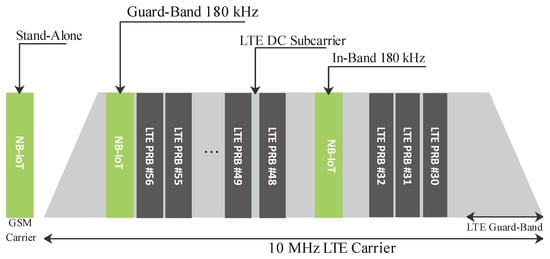
Figure 12. NB-IoT modes of deployment.
2.3.3. NB-IoT Comparison with Other IoT Technologies
In Table 5 [1][7][16][18][1,7,16,18], the comparison between NB-IoT, other licensed, and unlicensed band IoT is presented. The IoT operating in the licensed bands include eMTC, while LoRaWAN, SigFox, Ingenu, etc., are for the unlicensed band.
Table 5. Comparison between NB-IoT frequency band and other bands.
| Parameters | eMTC | NB-IoT | LoRa | SigFox |
|---|---|---|---|---|
| Spectral Bandwidth | 1.4 MHz | 180 KHz | 7.8–500 KHz | 200 KHz |
| Spectral Frequency Band (MHz) | 700–900 | 700–900 | 868 | 868 |
| Cellular | Cellular | ISM | ISM | |
| Licensed | Licensed | Unlicensed | Unlicensed | |
| Spectral Efficiency | High | High | Very Low | Very Low |
| Data Rate | <1 Mbps | <50 kbps | <10 kbps | 100 bps |
| Coverage Area | <10 km | <15 km | <10 km | <12 km |
| Terminal Cost ($-2020) | 3.3 | 2–3 | 2.64 | 2.64 |
| Power Efficiency | Medium-High | Medium-High | Very High | High |
| Interference Immunity | Medium | Medium | Very High | Medium |
| Standard | 3GPP Release 14 | 3 GPP Release 13 | LoRaWAN2 | ETSI |
Comparisons between NB-IoT and other LPWAN have been carried out to evaluate some features. These features include the cost of deployment, coverage range, interference immunity, power, and spectral efficiencies [6][7][16][81][82][6,7,16,81,82]. However, the results obtained showed that these technologies have some distinctive features that are suitable for specific purposes or applications. In some cases, trade-offs are required by the user for their deployments. An example is the deployment of NB-IoT in industries. Such decisions would leverage the existing infrastructure, security, and coverage of the LTE. Meanwhile, a decision that chooses LoRa, would require additional network infrastructure for deployment.
2.3.4. NB-IoT Applications in Industries
The application of NB-IIoT spans many of the industrial sectors with varying degrees of deployments [20]. This usually depends on the criticality and level of confidence in NB-IoT technology. However, its application has been forecast to increase in the foreseeable future especially with the increase in the manufacturing of NB-IoT modules by various vendors [2]. NB-IoT is deployed for different purposes in industries, as shown in Figure 13. In the oil and gas industries, NB-IoT deployment includes refining, distribution, and monitoring of products. Applications are also found in food processing, agriculture, and water industries.

Figure 13. Areas of NB-IoT applications in industries.
